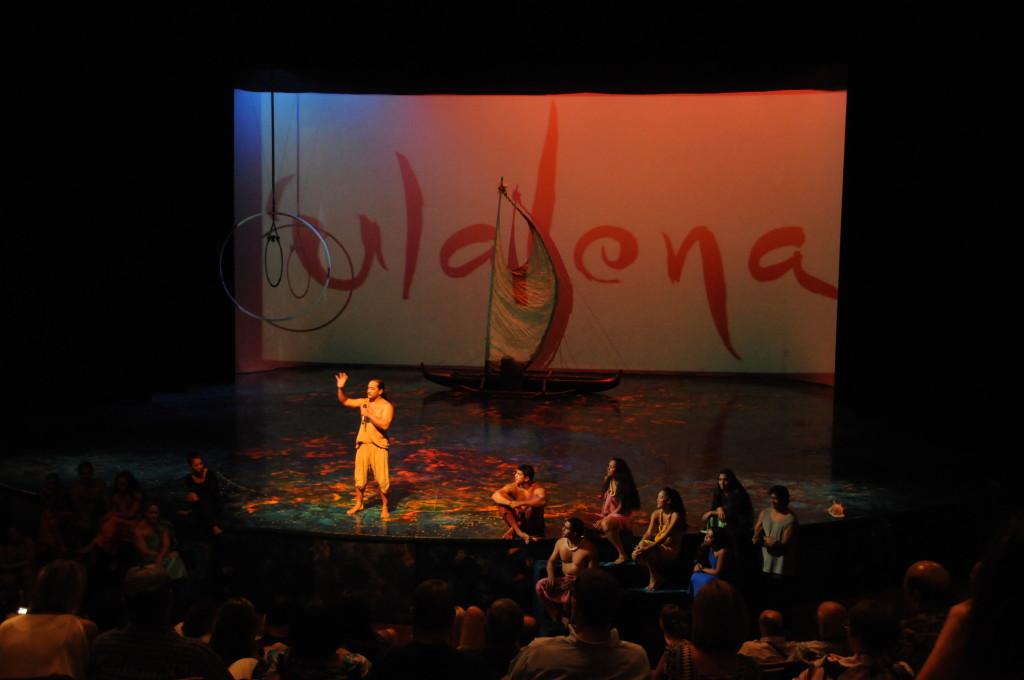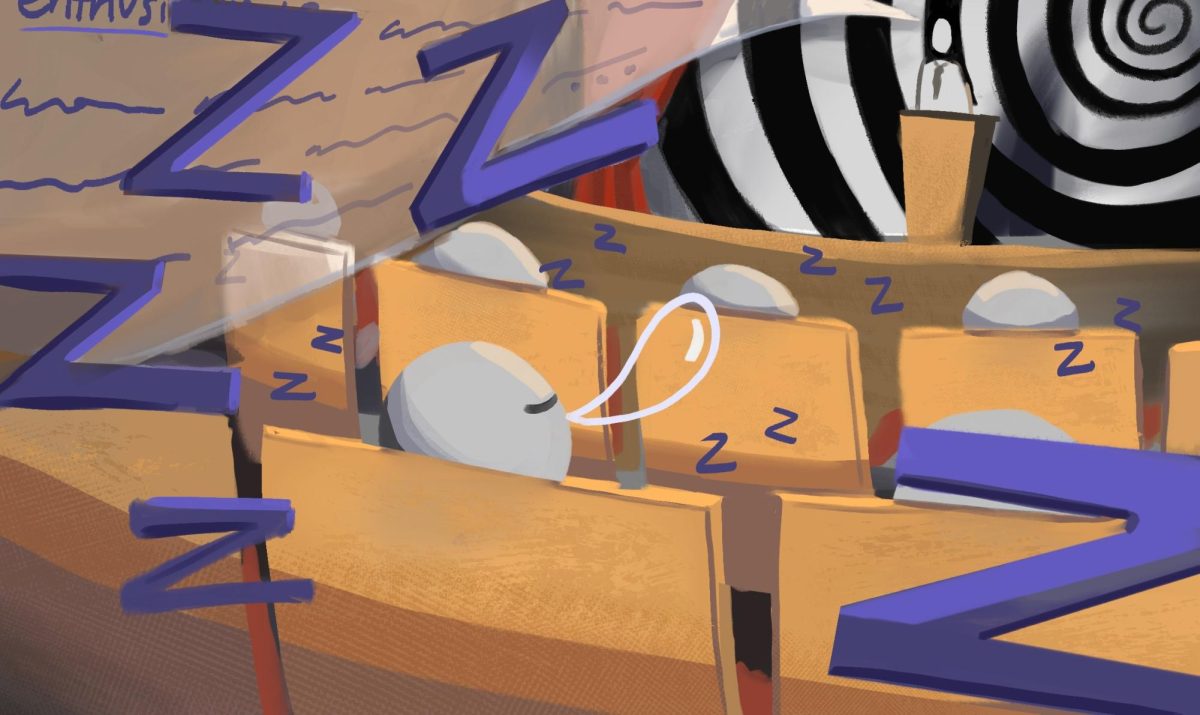The house lights dim as a swarm of vibrant colors fill the auditorium. Performers inch closer to the stage, appearing behind the audience. Sounds of instruments, some native to Hawaii, pervade the theatre. ‘Ulalena, a Maui Theatre production, with its grandiose audio and visual effects, captures the struggles and triumphs of the Hawaiian people.
Translating to “red-yellow rain” in Hawaiian, ‘Ulalena traces the rich history of Hawaii, dating back to the spiritual quests of the earliest inhabitants of the islands. The production opens with the “Kumulipo,” a creation chant, to commemorate the origins of life in the form of agriculture.
The next couple of scenes illustrate the natural spectacles that shaped the island. Appearances by Pele, the Volcano goddess, and Kamohoali’i, the Shark God, signify the unification of the ocean, forest, and land to become the island chain of Hawaii.
After explaining the natural phenomenons, the show progresses to highlight the villagers and the European explorers’ discovery of the island. King Kamehameha, due to the overpowering European weaponry, dies in a battle, and thus chaos ensues among the islanders.
The performance ends after the climactic explosion of Pele, causing mayhem to simmer and peace to once again pervade the islands. The Goddess of the moon, Hina, oversees the tranquil aftermath and guides the people to a life filled with serenity.
The flow of the story, however, may not be clearly depicted to the viewers. Between scenes, occasional narratives explaining the upcoming events allows the audience to enjoy the show with ease. Yet, the abrupt transitions and quickly paced plot can easily perplex viewers in a blink of an eye.
Throughout the show, ‘Ulalena’s music is performed live, either by performers on stage or by musicians in an alcove on the house balcony. Rhythmic, powerful drumming and beautiful strains of conch shell horn reverberate throughout the theater, penetrating each and every audience member and communicating the genuine passion of the performers.
The music’s deep cultural significance transcends its beautiful sound. Illustrating Hawaiian concepts of the beginning of time and the relationships between all living things, the opening number is based on a traditional chant and sets the tone for the show.
The rest of the show narrates the story of Hawaii by intertwining English, Portuguese, and traditional Hawaiian songs and instrumentals, communicating the depth of Hawaiian history through emotion that surpasses language barriers.
Similar to the audio effects, the visual elements of the show impress the audience with intricate stage designs. In contrast with the deceivingly simple exterior of the Maui Theatre, the visual effects featured inside the theatre are both symbolic and enhancing to the show experience. Throughout the production, various projections and animations, such as the sea, forest, and smoke, help convey the performance’s message to the audience.
An array of props is also used to further augment any sensations: fish on sticks waved around by actors in the sea, large sheets of red cloth representing flowing lava pulled across the audience, and even aerialists hanging by cloth to represent waterfalls and in rings to represent the moon.
Furthermore, snippets of comic relief placed at ideal moments throughout the show are both relatable and amusing for all ages. One notable part of the production involves Kamapua’a’s relentless goal to woo Pele.
Adding onto the experience of the show, the costumes certainly portray the creative vision of the designers and add to the visual magnificence of the show. One notable costume design, inspired by Lahaina’s famous Banyan tree, is featured in a stunning scene in which the trees of the rainforest suddenly burst with life. Performers on stilts glide onto the stage with long strips of brown, carefully stained cloth dragging behind them.
The dances performed enhances the show’s rich cultural aura. During the opening of the show, dancers stomp their feet to the rhythm of the drum beats. Although not a dance production, the tribal and rhythmic dancing adds to the ambience and overall enjoyment, further manifesting Hawaiian culture.
Intensifying the actors’ performance, the stage of ‘Ulalena is an integral part of the production. With three sets of curtains to portray different levels, the performers are able to provide incredible depth, and the cyclorama creates the detailed scenery unique to the show. In addition, gobo lights on the stage floor, patterned like coral reefs, add to the native Hawaiian atmosphere.
According to the Maui Theatre website, this unique stage was custom made for the show in Montreal, then shipped to and set up in Lahaina. The performance uses four computerized elevators that rise over seven feet high and a 22 foot wide rotating turntable, intertwining the apparati into complex dance routines for visual effect.
Furthermore, the theater boasts a state of the art sound system using 20 speakers and the island’s first L’Acoustic installed system, according to the Maui Theatre website.
If sound is spectacular at the Maui Theatre, the lighting is mind-blowing. With a variety of lighting cues and textures in use, the theater has over 24 moving lights, as well as more than 60 fixed ones. The lights are controlled by a computer, allowing a larger degree of artistic freedom.
With its traditional Hawaiian music, captivating visual effects, and innovative stage use, ‘Ulalena definitely lives up to its shining reputation. For those unfamiliar with the islands’ history, however, brushing up on Hawaiian legends before watching the show is highly recommended.
Contributing to the article: TalonWP, Winged Post, and Talon staff


















![“[Building nerf blasters] became this outlet of creativity for me that hasn't been matched by anything else. The process [of] making a build complete to your desire is such a painstakingly difficult process, but I've had to learn from [the skills needed from] soldering to proper painting. There's so many different options for everything, if you think about it, it exists. The best part is [that] if it doesn't exist, you can build it yourself," Ishaan Parate said.](https://harkeraquila.com/wp-content/uploads/2022/08/DSC_8149-900x604.jpg)




![“When I came into high school, I was ready to be a follower. But DECA was a game changer for me. It helped me overcome my fear of public speaking, and it's played such a major role in who I've become today. To be able to successfully lead a chapter of 150 students, an officer team and be one of the upperclassmen I once really admired is something I'm [really] proud of,” Anvitha Tummala ('21) said.](https://harkeraquila.com/wp-content/uploads/2021/07/Screen-Shot-2021-07-25-at-9.50.05-AM-900x594.png)







![“I think getting up in the morning and having a sense of purpose [is exciting]. I think without a certain amount of drive, life is kind of obsolete and mundane, and I think having that every single day is what makes each day unique and kind of makes life exciting,” Neymika Jain (12) said.](https://harkeraquila.com/wp-content/uploads/2017/06/Screen-Shot-2017-06-03-at-4.54.16-PM.png)








![“My slogan is ‘slow feet, don’t eat, and I’m hungry.’ You need to run fast to get where you are–you aren't going to get those championships if you aren't fast,” Angel Cervantes (12) said. “I want to do well in school on my tests and in track and win championships for my team. I live by that, [and] I can do that anywhere: in the classroom or on the field.”](https://harkeraquila.com/wp-content/uploads/2018/06/DSC5146-900x601.jpg)
![“[Volleyball has] taught me how to fall correctly, and another thing it taught is that you don’t have to be the best at something to be good at it. If you just hit the ball in a smart way, then it still scores points and you’re good at it. You could be a background player and still make a much bigger impact on the team than you would think,” Anya Gert (’20) said.](https://harkeraquila.com/wp-content/uploads/2020/06/AnnaGert_JinTuan_HoHPhotoEdited-600x900.jpeg)

![“I'm not nearly there yet, but [my confidence has] definitely been getting better since I was pretty shy and timid coming into Harker my freshman year. I know that there's a lot of people that are really confident in what they do, and I really admire them. Everyone's so driven and that has really pushed me to kind of try to find my own place in high school and be more confident,” Alyssa Huang (’20) said.](https://harkeraquila.com/wp-content/uploads/2020/06/AlyssaHuang_EmilyChen_HoHPhoto-900x749.jpeg)





















